
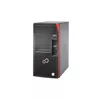
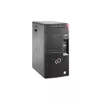
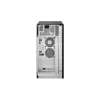
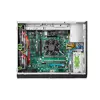
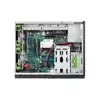
Fujitsu PRIMERGY TX1310 M3 Server 2000 GB Tower Intel® Xeon® E3-Prozessoren 3,3 GHz 8 GB DDR4-SDRAM 250 W
Hersteller: Fujitsu
Modell: VFY:T1313SC010IN
EAN: 4057185856607
Fujitsu PRIMERGY TX1310 M3. Prozessorfamilie: Intel® Xeon® E3-Prozessoren, Prozessor-Taktfrequenz: 3,3 GHz, Prozessor: E3-1225V6. RAM-Speicher: 8 GB, Interner Speichertyp: DDR4-SDRAM, Speicherlayout: 1 x 8 GB. Gesamtspeicherkapazität: 2000 GB, HDD Größe: 3.5 Zoll, HDD Schnittstelle: Serial ATA III. Eingebauter Ethernet-Anschluss, Verkabelungstechnologie: 10/100/1000Base-T(X). Optisches Laufwerk - Typ: DVD-RW. Stromversorgung: 250 W. Gehäusetyp: Tower
Keine Angebote gefunden...
Produktbewertungen von unseren Benutzern
Noch keine Kommentare
Nur registrierte Benutzer können Kommentare hinterlassen
Produktinformation
| Prozessor | |
| Prozessorhersteller | Intel |
| Prozessorfamilie | Intel® Xeon® E3-Prozessoren |
| Prozessor | E3-1225V6 |
| Prozessor-Taktfrequenz | 3,3 GHz |
| Prozessor Boost-Frequenz | 3,7 GHz |
| Anzahl Prozessorkerne | 4 |
| Prozessor-Cache | 8 MB |
| Motherboard Chipsatz | Intel® C236 |
| Speicherkanäle, vom Prozessor unterstützt | Dual |
| Anzahl installierter Prozessoren | 1 |
| Thermal Design Power (TDP) | 95 W |
| Prozessor Cache Typ | Smart Cache |
| Prozessorbetriebsmodi | 64-Bit |
| Execute Disable Bit | |
| Leerlauf Zustände | |
| Tcase | 72,6 °C |
| Thermal-Überwachungstechnologien | |
| Eingebettete Optionen verfügbar | |
| Speichertypen, vom Prozessor unterstützt | DDR3-SDRAM |
| Speichertaktraten, vom Prozessor unterstützt | 1066,1333 MHz |
| Durch den Prozessor (max) unterstützte Speicherbandbreite | 21 GB/s |
| ECC vom Prozessor unterstützt | |
| Prozessor-Paketgröße | 37.5 mm |
| Bus Typ | DMI |
| Prozessor Codename | Sandy Bridge |
| Maximale Anzahl der PCI-Express-Lanes | 2 |
| Stepping | D2 |
| Prozessorsockel | LGA 1155 (Socket H2) |
| Prozessor Lithografie | 32 nm |
| Maximaler interner Speicher, vom Prozessor unterstützt | 32 GB |
| Unterstützte Befehlssätze | AVX, SSE4.1, SSE4.2 |
| Prozessor-Threads | 4 |
| Prozessor-Code | SR00G |
| CPU-Multiplikator (Bus-/Kernverhältnis) | 31 |
| Design | |
| Gehäusetyp | Tower |
| Speicher | |
| Speicherkapazität | 8 GB |
| Interner Speichertyp | DDR4-SDRAM |
| Speicherlayout | 1 x 8 GB |
| Speichertaktfrequenz | 2400 MHz |
| ECC | |
| Speicherkartensteckplätze | 4 |
| RAM-Speicher maximal | 64 GB |
| Energie | |
| Unterstützung für redundantes Netzteil | |
| Stromversorgung | 250 W |
| Anzahl der Haupt-Netzteile | 1 |
| Stromversorgung - Eingangsfrequenz | 50 - 60 Hz |
| Speichermedium | |
| Gesamtspeicherkapazität | 2000 GB |
| Anzahl der installierten HDDs | 2 |
| HDD Kapazität | 1000 GB |
| HDD Schnittstelle | Serial ATA III |
| HDD Geschwindigkeit | 7200 RPM |
| HDD Größe | 3.5 " |
| Maximale unterstützte Anzahl der HDD | 4 |
| Unterstützte Hard-Disk Drive Größen | 3.5 " |
| SSD Schnittstelle | SATA III |
| RAID-Unterstützung | |
| RAID Level | 0, 1, 10 |
| Hot-Plug-Unterstützung | |
| Unterstützte Speicherlaufwerk-Schnittstellen | Serial ATA III |
| Optisches Laufwerk - Typ | DVD-RW |
| Anschlüsse und Schnittstellen | |
| Anzahl Ethernet-LAN-Anschlüsse (RJ-45) | 1 |
| Anzahl USB 2.0 Anschlüsse | 3 |
| USB 3.2 Gen 1 (3.1 Gen 1) Anzahl der Anschlüsse vom Typ A | 6 |
| Anzahl DisplayPort Anschlüsse | 1 |
| Grafik | |
| Eingebaute Grafikadapter | |
| On-Board-Grafikadapterfamilie | Intel® HD Graphics |
| Eingebautes Grafikkartenmodell | Intel® HD Graphics P3000 |
| On-Board Grafikadapter Basisfrequenz | 850 MHz |
| Maximale dynamische Frequenz der On-Board Grafikadapter | 1350 MHz |
| Maximaler integrierter Grafik-Adapterspeicher | 1,7 GB |
| Anzahl an unterstützen Displays (On-Board-Grafik) | 2 |
| On-Board Grafikadapter DirectX Version | 12.0 |
| On-Board Grafikadapter OpenGL Version | 4.4 |
| 4K-Unterstützung durch On-Board Grafikadapter | |
| On-Board Grafikadapter Geräte-ID | 0x191D |
| Erweiterungssteckplätze | |
| PCI-Express x1 (Gen 3.x)-Anschlüsse | 1 |
| PCI-Express x4 (Gen 3.x)-Anschlüsse | 1 |
| PCI-Express x16 (Gen 3.x)-Anschlüsse | 1 |
| PCI-Express-Slots-Version | 2.0 |
| Software | |
| Kompatible Betriebssysteme | Microsoft Hyper-V Server 2012 R2 Microsoft Hyper-V Server 2016 Microsoft Windows Server 2012 R2 Datacenter Microsoft Windows Server 2016 Datacenter Microsoft Windows Server 2012 R2 Standard Microsoft Windows Server 2016 Standard Microsoft Windows Server 2012 R2 Essentials Microsoft Windows Server 2016 Essentials Microsoft Windows Server 2012 R2 Foundation Microsoft Windows Storage Server 2012 R2 Standard Microsoft Windows Storage Server 2016 Standard Microsoft Hyper-V Server 2012 Microsoft Windows Server 2012 Datacenter Microsoft Windows Server 2012 Standard Microsoft Windows Server 2012 Essentials Microsoft Windows Server 2012 Foundation SUSE Linux Enterprise Server 12 Red Hat Enterprise Linux 7 |
| Betriebsbedingungen | |
| Betriebstemperatur | 10 - 35 °C |
| Gewicht und Abmessungen | |
| Breite | 180 mm |
| Tiefe | 305 mm |
| Höhe | 375 mm |
| Gewicht | 14 kg |
| Prozessor Besonderheiten | |
| Verbesserte Intel SpeedStep Technologie | |
| Intel® Trusted-Execution-Technik | |
| CPU Konfiguration (max) | 1 |
| Intel® Enhanced Halt State | |
| Intel® AES New Instructions (Intel® AES-NI) | |
| Intel® Smart Cache | |
| Intel® Flex Memory Access | |
| Intel® Hyper-Threading-Technik (Intel® HT Technology) | |
| Intel® Turbo-Boost-Technologie | 2.0 |
| Intel® Quick-Sync-Video-Technik | |
| Intel® InTru™ 3D Technologie | |
| Intel® Wireless-Display (Intel® WiDi) | |
| Intel® FDI-Technik | |
| Intel® Clear Video HD Technology für (Intel® CVT HD) | |
| Intel® Dual Display Capable Technology | |
| Intel® Fast Memory Access | |
| Intel® VT-x mit Extended Page Tables (EPT) | |
| Intel® Virtualization Technologie (VT-X) | |
| Intel® Identity Protection Technologieversion | 1,00 |
| Intel® Demand Based Switching | |
| Intel® 64 | |
| Intel® Virtualisierungstechnik für direkte I/O (VT-d) | |
| ARK Prozessorerkennung | 52270 |
| Technische Details | |
| Nachhaltigkeitszertifikate | EPEAT Gold |
| Netzwerk | |
| LAN-Controller | Intel® I219 |
| Ethernet/LAN | |
| Verkabelungstechnologie | 10/100/1000Base-T(X) |
| Ethernet Schnittstellen Typ | Gigabit Ethernet |
| Zertifikate | |
| Zertifizierung | CB, RoHS, WEEE, GS, CE, CSA us, ULc/us, FCC Class A, VCCI:V3 Class A + JIS 61000-3-2, KC, CCC, C-Tick (AS / NZS CISPR 22 Class A) |
| Leistungen | |
| Trusted Platform Module (TPM) | |